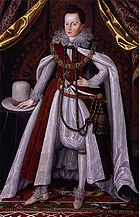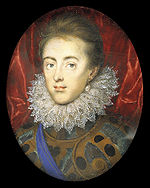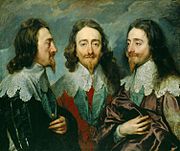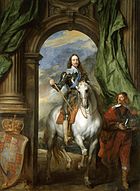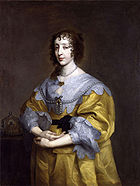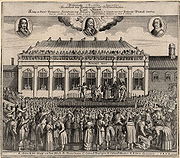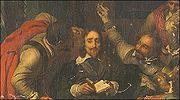
Charles I of England
Background to the schools Wikipedia
SOS Children produced this website for schools as well as this video website about Africa. All children available for child sponsorship from SOS Children are looked after in a family home by the charity. Read more...
| Charles I | |
|---|---|
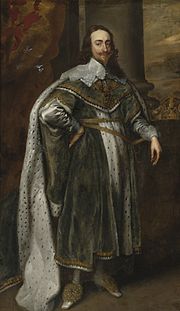 |
|
| Portrait by Anthony van Dyck, 1636 | |
|
|
|
| Reign | 27 March 1625 – 30 January 1649 |
| Coronation | 2 February 1626 |
| Predecessor | James I |
| Successor | Charles II ( de jure) Council of State ( de facto) |
|
|
|
| Reign | 27 March 1625 – 30 January 1649 |
| Coronation | 8 June 1633 |
| Predecessor | James VI |
| Successor | Charles II |
| Consort | Henrietta Maria of France |
| Issue | |
| Charles II Mary, Princess Royal and Princess of Orange James II & VII Princess Elizabeth Princess Anne Prince Henry, Duke of Gloucester Henrietta, Duchess of Orléans |
|
| House | House of Stuart |
| Father | James VI of Scotland and I of England |
| Mother | Anne of Denmark |
| Burial | 7 February 1649 Windsor, England |
Charles I (19 November 1600 – 30 January 1649) was the second son of James VI of Scots and I of England. He was King of England, King of Scotland, and King of Ireland from 27 March 1625 until his execution in 1649. Charles engaged in a struggle for power with the Parliament of England, attempting to obtain royal revenue whilst Parliament sought to curb his Royal prerogative which Charles believed was divinely ordained. Many of his English subjects opposed his actions, in particular his interference in the English and Scottish Churches and the levying of taxes without parliamentary consent which grew to be seen as those of a tyrannical absolute monarch.
Religious conflicts permeated Charles's reign. His failure to successfully aid Protestant forces during the Thirty Years' War, coupled with such actions as marrying a Catholic princess, generated deep mistrust concerning the king's dogma. Charles further allied himself with controversial religious figures, such as the ecclesiastic Richard Montagu, and William Laud, whom Charles appointed Archbishop of Canterbury. Many of Charles' subjects felt this brought the Church of England too close to the Catholic Church. Charles' later attempts to force religious reforms upon Scotland led to the Bishops' Wars, strengthened the position of the English and Scottish Parliaments and helped precipitate the king's downfall.
Charles' last years were marked by the English Civil War, in which he fought the forces of the English and Scottish Parliaments, which challenged the king's attempts to overrule and negate Parliamentary authority, whilst simultaneously using his position as head of the English Church to pursue religious policies which generated the antipathy of reformed groups such as the Puritans. Charles was defeated in the First Civil War (1642–45), after which Parliament expected him to accept its demands for a constitutional monarchy. He instead remained defiant by attempting to forge an alliance with Scotland and escaping to the Isle of Wight. This provoked the Second Civil War (1648–49) and a second defeat for Charles, who was subsequently captured, tried, convicted, and executed for high treason. The monarchy was then abolished and a republic called the Commonwealth of England, also referred to as the Cromwellian Interregnum, was declared. Charles' son, Charles II, though he became king at the death of his father, did not take up the reins of government until the restoration of the monarchy 1660. In that same year, Charles I was canonised as Saint Charles Stuart and King Charles the Martyr by the Church of England and is venerated throughout the Anglican Communion.
Early life
The second son of James VI of Scotland and Anne of Denmark, Charles was born in Dunfermline Palace, Fife on 19 November 1600. His paternal grandmother was Mary, Queen of Scots. Charles was baptised on 2 December 1600 by the Bishop of Ross, in a ceremony held in Holyrood Abbey and was created Duke of Albany, Marquess of Ormond, Earl of Ross and Lord Ardmannoch.
Charles was a weak and sickly infant. When Elizabeth I of England died in March 1603 and James VI of Scotland became King of England as James I, Charles was not considered strong enough to survive the journey to London due to his fragile health. While his parents and older siblings left for England in April and May that year, Charles remained in Scotland, with his father's friend and the Lord President of the Court of Session, Alexander Seton, Lord Fyvie, appointed as his guardian.
By the spring of 1604, Charles was three and a half and was by then able to walk the length of the great hall at Dunfermline Palace unaided. It was decided that he was now strong enough to make the journey to England to be reunited with his family, and on 13 July 1604 Charles left Dunfermline for England, where he was to spend most of the rest of his life. In England, Charles was placed under the charge of Alletta (Hogenhove) Carey, the Dutch-born wife of courtier Sir Robert Carey, who taught him how to walk and talk, and insisted that he wear boots made of Spanish leather and brass to help strengthen his weak ankles. However, Charles apparently eventually conquered his physical infirmity, which may be attributable to rickets and grew to an about average height of 5 feet 4 inches (162.56 cm).
Charles was not as valued as his physically stronger, elder brother, Henry, Prince of Wales; whom Charles personally adored and attempted to emulate. In 1605, Charles was created Duke of York, which is customary in the case of the sovereign's second son. However, when Henry died of suspected typhoid (or possibly porphyria) at the age of 18 in 1612, two weeks before Charles' 12th birthday, Charles became heir apparent. As the eldest living son of the sovereign Charles automatically gained several titles (including Duke of Cornwall and Duke of Rothesay), and subsequently was created Prince of Wales and Earl of Chester in November 1616.
In 1613, his sister Elizabeth married Frederick V, Elector Palatine and moved to Heidelberg. In 1617 the Catholic Ferdinand II was elected king of Bohemia. The following year, the people of Bohemia rebelled against their monarch, choosing to crown Frederick V of the Palatinate, and leader of the Protestant Union in his stead. Frederick's acceptance of the crown in November 1619 thus marked the beginning of turmoil which would develop into the Thirty Years' War. This conflict made a great impression upon the English Parliament and public, who quickly grew to see it as a polarised continental struggle between Catholic and Protestant. James, who was supportive of Frederick, and had been seeking marriage between the new Prince of Wales and the Spanish Infanta, Maria Anna of Spain, since Prince Henry's death, began to see the Spanish Match as a possible means of achieving peace in Europe.
Unfortunately for James, this diplomatic negotiation with Spain proved generally unpopular, both with the public and James' court, with ' Arminian' divines providing a unique source of support for the proposed union. Parliament was actively hostile towards the Spanish throne, and thus, when called by James, hoped for a crusade under the leadership of the king to rescue Protestants on the continent from Habsburg rule. Attacks upon the monopolists by Parliament for the abuse of prices led to the scapegoating of Francis Bacon by George Villiers, 1st Duke of Buckingham, leading to Bacon's impeachment before the Lords; the first of its kind which was not officially sanctioned by the King in the form of a Bill of attainder since 1459. The incident set an important precedent in terms of the apparent authority of Parliament to safeguard the nation's interests and its capacity to launch legal campaigns, as it later did against Buckingham, Archbishop Laud, the Earl of Strafford and Charles I. However, parliament and James came to blows when the issue of foreign policy was discussed, with James insisting that the Commons be exclusively concerned with domestic affairs. The members of the Commons, meanwhile, protested that they had the privilege of free speech within the Commons' walls. In January 1622 James dissolved the Parliament.
Charles, and the Duke of Buckingham, James' favourite and a man who had great influence over the prince, together travelled incognito to Spain in 1623 in an attempt to reach agreement on the long-pending Spanish Match. The trip ended as an embarrassing failure however as the Spanish demanded that Charles must convert to Roman Catholicism and remain in Spain for a year after the wedding as hostage to ensure England's compliance with all the terms of the treaty. Moreover, a personal quarrel erupted between Buckingham and the Spanish nation between whom was mutual misunderstanding and ill temper. Charles was outraged, and upon their return in October, he and Buckingham demanded that King James declare war on Spain.
With the encouragement of his Protestant advisers, James summoned Parliament in 1624 so that he could request subsidies for a war. At the behest of Charles and Buckingham, James assented to the impeachment of the Lord Treasurer, Lionel Cranfield, 1st Earl of Middlesex by the House of Commons, who quickly fell in much the same manner as Bacon had. James also requested that Parliament sanction the marriage between the Prince of Wales and Princess Henrietta Maria of France, whom Charles had met in Paris while en route to Spain. It was a good match since she was a sister of Louis XIII (their father, Henry IV, had died during her childhood). Parliament reluctantly agreed to the marriage, with the promise from both James and Charles that the marriage would not entail a liberty of religion being accorded to any Roman Catholic not of the Princess' own household. By 1624, James was growing sick, and as a result was finding it extremely difficult to control Parliament. By the time of his death, February 1625, Charles and the Duke of Buckingham had already achieved de facto control of the kingdom.
| Scottish and English Royalty |
|---|
| House of Stuart |
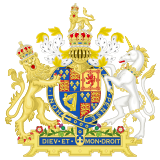 |
| Charles I |
| Charles II |
| James II & VII |
| Henry, Duke of Gloucester |
| Mary, Princess Royal |
| Henriette, Duchess of Orléans |
| Elizabeth |
Both Charles and James were advocates of the divine right of kings, but whilst James' lofty ambitions concerning absolute prerogative were tempered by compromise and consensus with his subjects, Charles I believed that he had no need of Parliamentary approval, that his foreign ambitions, which were greatly expensive and fluctuated wildly should have no legal impediment, and that he was himself above reproach. Charles believed he had no need to compromise or even explain his actions and that he was answerable only to God, famously stating: "Kings are not bound to give an account of their actions but to God alone".
Early reign
On 11 May 1625, Charles was married by proxy to Henrietta Maria in front of the doors of the Notre Dame de Paris, before his first Parliament could meet to forbid the banns. Many members were opposed to the king marrying a Roman Catholic, fearing that Charles would lift restrictions on Roman Catholics and undermine the official establishment of Protestantism. Although he stated to Parliament that he would not relax restrictions relating to recusants, he promised to do exactly that in a secret marriage treaty with Louis XIII of France. Moreover, the price of marriage with the French princess was a promise of English aid for the French crown in the suppressing of the Protestant Huguenots at La Rochelle, thereby reversing England's long held position in the French Wars of Religion. The couple were married in person on 13 June 1625 in Canterbury and Charles himself was crowned on 2 February 1626 at Westminster Abbey, but without his wife at his side due to the controversy. Charles and Henrietta had seven children, with three sons and three daughters surviving infancy.
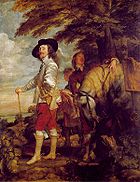
Distrust of Charles' religious policies increased with his support of a controversial ecclesiastic, Richard Montagu. In his pamphlets A New Gag for an Old Goose, a reply to the Catholic pamphlet A New Gag for the new Gospel, and also his Immediate Addresse unto God alone, Montagu argued against Calvinist predestination, thereby bringing himself into disrepute amongst the Puritans. After a Puritan member of the House of Commons, John Pym, attacked Montagu's pamphlet during debate, Montagu requested the king's aid in another pamphlet entitled " Appello Caesarem"(1625), (a reference to an appeal against Jewish persecution made by Saint Paul the Apostle). Charles made the cleric one of his royal chaplains, increasing many Puritans' suspicions as to where Charles would lead the Church, fearing that his favouring of Arminianism was a clandestine attempt on Charles' part to aid the resurgence of Catholicism within the English Church.
Charles' primary concern during his early reign was foreign policy. The Thirty Years' War, originally confined to Bohemia, was spiralling into a wider European war. In 1620 Frederick V was defeated at the Battle of White Mountain and by 1622, despite the aid of English volunteers, had lost his hereditary lands in the Palatinate to the Holy Roman Emperor Ferdinand II. Having agreed to help his brother-in-law regain the Palatinate, Charles declared war on Spain, which under the Catholic King Philip IV had sent forces to help occupy the Palatinate.
Parliament preferred an inexpensive naval attack on Spanish colonies in the New World, hoping that the capture of the Spanish treasure fleets could finance the war. Charles, however, preferred more aggressive (and more expensive) action on the Continent. Parliament only voted to grant a subsidy of £140,000; an insufficient sum for Charles. Moreover, the House of Commons limited its authorisation for royal collection of tonnage and poundage (two varieties of customs duties) to a period of one year, although previous sovereigns since 1414 had been granted the right for life. In this manner, Parliament could keep a check on expenditures by forcing Charles to seek the renewal of the grant each year. Charles' allies in the House of Lords, led by the Duke of Buckingham, refused to pass the bill. Although no Parliamentary Act for the levy of tonnage and poundage was obtained, Charles continued to collect the duties.
The war with Spain under the leadership of Buckingham went badly, and the House of Commons began proceedings for the impeachment of the duke. Charles nominated Buckingham as Chancellor of Cambridge University in response and on 12 June 1626, the House of Commons launched a direct protestation, stating, 'We protest before your Majesty and the whole world that until this great person be removed from intermeddling with the great affairs of state, we are out of hope of any good success; and we do fear that any money we shall or can give will, through his misemployment, be turned rather to the hurt and prejudice of your kingdom.' Despite Parliament's protests, however, Charles refused to dismiss his friend, dismissing Parliament instead.
Charles provoked further unrest by trying to raise money for the war through a "forced loan" -- a tax levied without Parliamentary consent. In November 1627, the test case in the King's bench, - the ' Five Knights' Case' - the king's prerogative right to imprison without trial those who refused to pay the forced load, was on a general basis, upheld. Summoned again in 1628, Parliament adopted a Petition of Right on 26 May, calling upon the king to acknowledge that he could not levy taxes without Parliament's consent, impose martial law on civilians, imprison them without due process, or quarter troops in their homes. Charles assented to the petition, though he continued to claim the right to collect customs duties without authorisation from Parliament.
Despite Charles' agreement to suppress La Rochelle as a condition of marrying Henrietta Maria, Charles reneged upon his earlier promise and instead launched a poorly conceived and executed defence of the fortress under the leadership of Buckingham in 1628 - thereby driving a wedge between the English and French Crowns that was not surmounted for the duration of the 30 Years' War. Buckingham's failure to protect the Huguenots - indeed, his attempt to capture Saint-Martin-de-Ré spurred Louis XIII's attack on the Huguenot fortress of La Rochelle - furthered Parliament's detestation of the Duke and the king's close proximity to this eminence grise. On 23 August 1628, Buckingham was assassinated. The public rejoicing at his death accentuated the gulf between the court and the nation, and between the crown and the Commons. Although the death of Buckingham effectively ended the war with Spain and eliminated his leadership as an issue, it did not end the conflicts between Charles and Parliament over taxation and religious matters.
Personal rule
In January 1629, Charles opened the second session of the Parliament, which had been prorogued in June 1628, with a moderate speech on the tonnage and poundage issue. Members of the House of Commons began to voice their opposition in light of the Rolle case, in which the autonomous MP had had his goods confiscated for failing to pay tonnage and poundage. Many MPs viewed the confiscation as a breach of the Petition of Right, arguing that the petition's freedom-from-arrest privilege extended to goods. When Charles ordered a parliamentary adjournment in March, members held the Speaker, Sir John Finch, down in his chair so that the dissolving of Parliament could be delayed long enough for resolutions against Catholicism, Arminianism and poundage and tonnage to be read out. The lattermost resolution declared that anyone who paid tonnage or poundage not authorised by Parliament would "be reputed a betrayer of the liberties of England, and an enemy to the same", and, although the resolution was not formally passed, many members declared their approval. Nevertheless, the provocation was too much for Charles, who dissolved parliament the same day. Moreover, eight parliamentary leaders, including John Eliot, were imprisoned on the foot of the matter, thereby turning these men into martyrs, and giving popular cause to a protest that had hitherto been losing its bearings.
Shortly after the proroguing of Parliament, without the means in the foreseeable future to raise funds for a European War from Parliament, or the influence of Buckingham, Charles made peace with France and Spain. The following eleven years, during which Charles ruled without a Parliament, are referred to as the Personal Rule or the Eleven Years' Tyranny. (Ruling without Parliament, though an exceptional exercise of the royal prerogative, was supported by precedent. By the middle of the 17th century, opinion shifted, and many held the Personal Rule to be an illegitimate exercise of arbitrary, absolute power.)
Economic problems
The reigns of Elizabeth I and James I had generated a large fiscal deficit for the kingdom. Notwithstanding the failure of Buckingham in the short lived campaigns against both Spain and France, there was in reality little economic capacity for Charles to wage wars overseas. England was still the least taxed country in Europe, with no official excise and no regular direct taxation. Without the consent of Parliament, Charles' capacity to acquire funds for his treasury was theoretically hamstrung, legally at least. To raise revenue without reconvening Parliament, Charles first resurrected an all-but-forgotten law called the "Distraint of Knighthood", promulgated in 1279, which required anyone who earned £40 or more each year to present himself at the King's coronation to join the royal army as a knight. Relying on this old statute, Charles fined all individuals who had failed to attend his coronation in 1626.
Later, Charles reintroduced obsolete feudal taxes such as purveyance, wardship, and forest laws. Chief among these taxes was one known as Ship Money, which proved even more unpopular, and lucrative, than poundage and tonnage before it. Under statutes of Edward I and Edward III, collection of ship money had been authorised only during wars, and only on coastal regions. Charles, however, argued that there was no legal bar to collecting the tax during peacetime and throughout the whole of the kingdom. Ship Money provided between £150,000 to £200,000 annually between 1634–1638, after which yields declined steeply. This was paid directly to Treasury of the Navy, thus making Northumberland the most direct beneficiary of the tax. Opposition to Ship Money steadily grew, with John Hampden's legal challenge in 1637 providing a platform of popular protest. However, the royal courts declared that the tax was within the King's prerogative.
The king also derived money through the granting of monopolies, despite a statute forbidding such action ( The Monopolies Act, 1624), which, though inefficient, raised an estimated £100,000 a year in the late 1630s in royal revenue. Charles also gained funds through the Scottish nobility, at the price of considerable acrimony, by the Act of Revocation (1625), whereby all gifts of royal or church land made to the nobility were revoked, with continued ownership being subject to an annual rent.
Religious conflicts
Throughout Charles's reign, the issue of how far the English Reformation should progress was constantly brought to the forefront of political debate. Arminian theology contained an emphasis on clerical authority and the individual's capacity to reject salvation, and was consequently viewed as heretical and a potential vehicle for the reintroduction of Roman Catholicism by its opponents. Charles's sympathy to the teachings of Arminianism, and specifically his wish to move the Church of England away from Calvinism in a more traditional and sacramental direction, consistently affirmed Puritans' suspicions concerning the perceived irreligious tendencies of the crown. A long history of opposition to tyrants who oppressed Protestants had developed since the beginning of the Protestant Reformation, most notably during the French Wars of Religion (articulated in the Vindiciae contra tyrannos), and more recently in the Second Defenestration of Prague and eruption of the Thirty Years' War. Such cultural identifications resonated with Charles's subjects. These allegations would haunt Charles because of the continued exacerbating actions of both king and council, particularly in the form of Archbishop William Laud.
William Laud was appointed Archbishop of Canterbury in 1633, and began a series of unpopular reforms such as attempting to ensure religious uniformity by dismissing non-conformist clergymen, and closing Puritan organisations. His policy was opposed to Calvinist theology, and he insisted that the Church of England's liturgy be celebrated using the form prescribed in the Book of Common Prayer, and that the internal architecture of English churches be reorganised so as to emphasise the sacrament of the altar, thereby attacking predestination. To punish those who refused to accept his reforms, Laud used the two most feared and most arbitrary courts in the land, the Court of High Commission and the Court of Star Chamber. The former could compel individuals to provide self-incriminating testimony, whilst the latter, essentially an extension of the Privy Council, could inflict any punishment whatsoever (including torture), with the sole exception of death.
The first years of the Personal Rule were marked by peace in England, partly because of tighter central control. Several individuals opposed Charles's taxes and Laud's policies, and some left as a result, such as the Puritan minister Thomas Hooker, who set sail for America along with other religious dissidents in the Griffin (1634). By 1633 Star Chamber had, in effect, taken the place of High Commission as the supreme tribunal for religious offences as well as dealing with Crown cases of a secular nature. Under Charles's reign, defendants were regularly brought before the Court without indictment, due process of the law, or right to confront witnesses, and their testimonies were routinely extracted by the Court through torture.
However, when Charles attempted to impose his religious policies in Scotland he faced numerous difficulties. Although born in Scotland, Charles had become estranged from his kingdom; not even paying visit until his Scottish coronation in 1633. In 1637 the king ordered the use of a new Prayer Book to be used within Scotland that was almost identical to the English Book of Common Prayer, without consultation with either the Scottish Parliament or Kirk. Although this move was supported by the Scottish Bishops, it was resisted by many Presbyterian Scots, who saw the new Prayer Book as a vehicle for introducing Anglicanism to Scotland. In 1637, spontaneous unrest erupted throughout the Kirk upon the first Sunday of its usage, and the public began to mobilise around rebellious nobles in the form of the National Covenant. When the General Assembly of the Church of Scotland abolished Episcopalian government (that is, governance of the Church by bishops) in 1638, replacing it with Presbyterian government (that is, governance by elders and deacons), Charles sought to put down what he saw as a rebellion against his authority.
In 1639, when the First Bishops' War broke out, Charles did not seek subsidies to wage war, but instead raised an army without Parliamentary aid. However, Charles's army did not engage the Covenanters as the king was afraid of the defeat of his forces, whom he believed to be significantly outnumbered by the Scots. In the Pacification of Berwick, Charles regained custody of his Scottish fortresses, and secured the dissolution of the Covenanters' interim government, albeit at the decisive concession whereby both the Scottish Parliament and General Assembly of the Scottish Church were called.
Charles's military failure in the First Bishops' War in turn caused a financial and military crisis for Charles, which ultimately ended the period of Personal Rule. Charles's peace negotiations with the Scots were merely a bid by the king to gain time before launching a new military campaign. However, because of his financial weakness, Charles was forced to call Parliament into session by 1640 in an attempt to raise funds for such a venture. The risk for the king lay in the forum that Parliament would provide to his opponents, whilst the intransigence of the 1628 Parliament augured badly for the prospects of obtaining the necessary subsidy for war.
The Second Bishops' War
Charles collectively summoned both English and Irish parliaments in the early months of 1640. In March, 1640 the Irish Parliament duly voted in a subsidy of £180,000 with the promise to raise an army 9,000 strong by the end of May. However, in the English General Election in March, court candidates fared badly, and Charles' dealings with the English Parliament in April quickly reached stalemate. Northumberland and Strafford together attempted to reach a compromise whereby the king would agree to forfeit Ship Money in exchange for £650,000 (although the coming war was estimated at around £1 million). Nevertheless, this alone was insufficient to produce consensus in the Commons. The Parliamentarians' calls for further reforms were ignored by Charles, who still maintained the support of the House of Lords. Despite the protests of Northumberland, Parliament was dissolved less than a month after it assembled, in May 1640; thus causing it to be known as the " Short Parliament".
By this stage Thomas Wentworth, created Earl of Strafford and elevated to Lord Lieutenant of Ireland in January 1640, had emerged as Charles' right hand man and together with Laud, pursued a policy of ' thorough'. Although originally a major critic of the king, Strafford defected to royal service in 1628 (due in part to Buckingham's persuasion); since emerging as the most capable of Charles' ministers. Having trained up a large army in Ireland in support of the king, and seriously weakened the authority of the Irish Parliament, particularly those members of parliament belonging to the Old English, Strafford had been instrumental in obtaining an independent source of both royal revenue and forces within the three kingdoms. As the Scottish Parliament declared itself capable of governing without the king's consent and, in September 1640, moved into Northumberland under the leadership of Montrose, Strafford was sent north to command the English forces following Northumberland's illness. The Scottish soldiery, many of whom were veterans of the Thirty Years' War, had far greater morale and training compared to their English counterparts, and met virtually no resistance until reaching Newcastle where, at the Battle of Newburn, Newcastle-upon-Tyne —and hence England's coal supply—fell into the hands of the Covenanter forces. At this critical juncture, the English host based at York was unable to mount a counterattack because Strafford was incapacitated by a combination of gout and dysentery.
On 24 September Charles took the unusual step of summoning the magnum concilium, the ancient council of all the Peers of the Realm, who were considered the King's hereditary counsellors, who recommended making peace with the Scots and the recalling of Parliament. A cessation of arms, although not a final settlement, was agreed in the humiliating Treaty of Ripon, signed October 1640. The treaty stated that the Scots would continue to occupy Northumberland and Durham and be paid £850 per day, until peace was restored and the English Parliament recalled (which would be required to raise sufficient funds to pay the Scottish forces). Consequently, in November Charles summoned what was later to become known as the Long Parliament. Of the 493 MPs of the Commons, 399 were opposed to the king, and only 94 could be counted on, by Charles, for support.
.
The "Long Parliament"
The Long Parliament assembled in November 1640 and proved just as difficult for Charles as had the Short Parliament. The Parliament quickly began proceedings to impeach Laud of High Treason, which it succeeded in doing on 18 December. Lord Keeper Finch was impeached the following day, and he consequently fled to the Hague with Charles' permission on 21 December. To prevent the king from dissolving it at will, Parliament passed the Triennial Act, to which the Royal Assent was granted in February 1641. The Act required that Parliament was to be summoned at least once every three years, and that when the King failed to issue proper summons, the members could assemble on their own.
On 22 March 1641, Strafford, who had become the immediate target of the Parliamentarians, particularly that of John Pym, went on trial for high treason. The incident provided a new departure for Irish politics whereby Old English, Gaelic Irish and New English settlers joined together in a legal body to present evidence against Strafford. However, the evidence supplied by Sir Henry Vane in relation to Strafford's alleged improper use and threat to England via the Irish army was not corroborated and on 10 April Pym's case collapsed. Pym immediately launched a Bill of Attainder, simply stating Strafford's guilt and that the Earl be put to death.
Charles, however guaranteed Strafford that he would not sign the attainder, without which the bill could not be passed. Furthermore, the Lords were opposed to the severity of the sentence of death imposed upon Strafford. Yet, increased tensions and an attempted coup by the army in support of Strafford began to sway the issue. On 21 April, in the Commons the Bill went virtually unopposed (204 in favour, 59 opposed, and 250 abstained), the Lords acquiesced, and Charles, fearing for the safety of his family, signed on 10 May. The Earl of Strafford was beheaded two days later.
In May 1641, Charles assented to an unprecedented act, which forbade the dissolution of the English Parliament without Parliament's consent. Ship money, fines in destraint of knighthood and forced loans were declared unlawful, monopolies were cut back severely, and the Courts of Star Chamber and High Commission were abolished. All remaining forms of taxation were legalised and regulated by the Tonnage and Poundage Act. On 3 May, Parliament decreed The Protestation, attacking the 'wicked counsels' of Charles' government, whereby those who signed the petition undertook to defend 'the true reformed religion', parliament, and the king's person, honour and estate. Throughout May, the House of Commons launched several bills attacking bishops and episcopalianism in general, each time defeated in the Lords.
Although he made several important concessions, Charles improved his own military position by securing the favour of the Scots that summer by promising the official establishment of Presbyterianism. In return, he was able to enlist considerable anti-parliamentary support. However, following the attempted coup of ' The Incident' in Scotland, Charles' credibility was significantly undermined.
The Irish Rebellion
In a similar manner as pursued by the English Parliament in their opposition to Buckingham, albeit from a far less disingenuous stance, the Old English members of the Irish Parliament argued that their opposition to Strafford had not negated their loyalty to Charles. They argued that Charles had been led astray by the malign influence of the Earl, and that, moreover, the ambiguity surrounding Poynings' Law meant that, instead of ensuring that the king was directly involved in the governance of Ireland, that a viceroy such as Strafford, the Earl of Wentworth, could emerge as a despotic figure. However, unlike their Old English counterparts who were Catholic, the New English settlers in Ireland were Protestant and could loosely be defined as aligned with the English Parliament and the Puritans; thereby fundamentally opposed to the crown due to unfolding events within England herself.
Various disputes between native and coloniser concerning a transference of land ownership from Catholic to Protestant, particularly in relation to the plantation of Ulster, coupled with the gradual overshadowing of the Irish Parliament by the English Parliament would sow the seeds of conflagration in Ireland that, despite its initial chaos, provide the catalyst for direct armed combat within England between royalists and parliamentarians. The success of the trial against Strafford weakened Charles' influence in Ireland, whilst also providing a natural conduit for cooperation between the Gaelic Irish and Old English, who had hitherto been antagonistic towards one another. Thus, in the conflict between the Gaelic Irish, and New English settlers, in the Irish Rebellion of 1641, the Old English sided with the Gaelic Irish whilst simultaneously professing their loyalty to the king.
Though in November 1641 the House of Commons passed the Grand Remonstrance, a long list of grievances against actions by Charles' ministers committed since the beginning of his reign that were asserted to be part of a grand Catholic conspiracy which the king was an unwitting member, it was in many ways a step too far by Pym (passed by 6 votes, 200 abstained). Furthermore the Remonstrance attacked the members of the House of Lords as being guilty of blocking reform, who duly defeated the Remonstrance when brought before them. The tension was heightened when news of the Irish rebellion reached Parliament, coupled with rumours of Charles' complicity. The Irish Catholic army, established by Strafford, whose dissolution had been demanded thrice by the House of Commons, professed their loyalty to the king. This was combined with the massacres of Protestant New English in Ireland by Gaelic Irish who could not be controlled by their lords, and proved to be the final antinomy between the English Parliament and the king in relation to Charles' authority to govern. Throughout November a storm of publicity concerning the Irish depositions, coupled with stories concerning 'Papist conspiracies' alive within England herself circulated the kingdom, and were published in the form of a series of alarmist pamphlets.
The English Parliament did not trust Charles' motivations when he called for funds to put down the rebellion, many members of the House of Commons fearing that forces raised by Charles might later be used against Parliament itself. The Militia Bill was intended to wrest control of the army from the King, but it did not have the support of the Lords, let alone the king. Indeed, the Militia Ordinance appears to have been the single most decisive moment in prompting an exodus from the Upper House to support Charles. In an attempt to strengthen his position, Charles generated great apathy in London, which was already fast falling into anarchy, when he placed the Tower of London under the command of Colonel Thomas Lunsford, an infamous, albeit efficient, career officer. When rumours reached Charles that Parliament intended to impeach his Catholic Queen, Henrietta Maria, the king decided to take drastic action which would not only end the diplomatic stalemate between himself and Parliament, but signal the beginning of the civil war.
Charles suspected, correctly, that there were members of the English Parliament who had colluded with the invading Scots. On 3 January, Charles directed Parliament to give up five members on the grounds of High Treason. When Parliament refused, it was possibly Henrietta who persuaded Charles to arrest the five members by force, which Charles intended to carry out personally. However, news of the warrant reached Parliament ahead of him, and the wanted men, Pym, John Hampden, Denzil Holles, William Strode and Sir Arthur Haselrig had slipped away shortly before Charles entered the House of Commons with an armed guard on 4 January 1642. Having displaced the Speaker, William Lenthall from his chair, the king asked him where the MPs had fled. Lenthall famously replied, "May it please your Majesty, I have neither eyes to see nor tongue to speak in this place but as the House is pleased to direct me, whose servant I am here." Charles abjectly declared 'all my birds have flown', and was forced to retire, empty-handed.
The botched arrest attempt was politically disastrous for Charles. In one stroke Charles destroyed his supporters' arguments that the king was the only bulwark against a rising tide of innovation and disorder. No English sovereign ever had (or has since that time) entered the House of Commons by force. Parliament quickly seized London, and on 10 January 1642, Charles was forced to leave the capital, where he began travelling north to raise an army against his Parliament.
English Civil War
The English Civil War had not yet started, but both sides began to arm. Following futile negotiations, Charles raised the royal standard in Nottingham on 22 August 1642. He then set up his court at Oxford, when his government controlled roughly the Midlands, Wales, the West Country and north of England. Parliament remained in control of London and the south-east as well as East Anglia. Charles raised an army using the archaic method of the Commission of Array. The Civil War started on 26 October 1642 with the inconclusive Battle of Edgehill and continued indecisively through 1643 and 1644, until the Battle of Naseby tipped the military balance decisively in favour of Parliament. There followed a great number of defeats for the Royalists, and then the Siege of Oxford, from which Charles escaped in April 1646. He put himself into the hands of the Scottish Presbyterian army at Newark, and was taken to nearby Southwell while his "hosts" decided what to do with him. The Presbyterians finally arrived at an agreement with Parliament and delivered Charles to them in 1647. He was imprisoned at Holdenby House in Northamptonshire, until cornet George Joyce took him by force to Newmarket in the name of the New Model Army. At this time mutual suspicion had developed between the New Model Army and Parliament, and Charles was eager to exploit it.
He was then transferred first to Oatlands and then Hampton Court, where more involved but fruitless negotiations took place. He was persuaded that it would be in his best interests to escape—perhaps abroad, to France, or to the custody of Colonel Robert Hammond, Parliamentary Governor of the Isle of Wight. He decided on the last course, believing Hammond to be sympathetic, and fled on 11 November. Hammond, however, was opposed to Charles, whom he confined in Carisbrooke Castle.
From Carisbrooke, Charles continued to try to bargain with the various parties. In direct contrast to his previous conflict with the Scottish Kirk, Charles on 26 Dec. 1647 signed a secret treaty with the Scots. Under the agreement, called the " Engagement", the Scots undertook to invade England on Charles' behalf and restore him to the throne on condition of the establishment of Presbyterianism for three years.
The Royalists rose in July 1648 igniting the Second Civil War, and as agreed with Charles, the Scots invaded England. Most of the uprisings in England were put down by forces loyal to Parliament after little more than skirmishes, but uprisings in Kent, Essex, and Cumberland, the rebellion in Wales, and the Scottish invasion involved the fighting of pitched battles and prolonged sieges. But with the defeat of the Scots at the Battle of Preston, the Royalists lost any chance of winning the war.
Trial
Charles was moved to Hurst Castle at the end of 1648, and thereafter to Windsor Castle. In January 1649, in response to Charles' defiance of Parliament even after defeat, and his encouraging the second Civil War while in captivity, the House of Commons passed an Act of Parliament creating a court for Charles' trial. After the first Civil War, the parliamentarians accepted the premise that the king, although wrong, had been able to justify his fight, and that he would still be entitled to limited powers as King under a new constitutional settlement. It was now felt that by provoking the second Civil War even while defeated and in captivity, Charles showed himself responsible for unjustifiable bloodshed. The secret treaty with the Scots was considered particularly unpardonable; "a more prodigious treason", said Cromwell, "than any that had been perfected before; because the former quarrel was that Englishmen might rule over one another; this to vassalise us to a foreign nation." Cromwell had up to this point supported negotiations with the king, but now rejected further diplomacy.
The idea of trying a king was a novel one; previous monarchs (Edward II, Richard II and Henry VI) had been overthrown and murdered by their successors, but had never been brought to trial as monarchs. Charles was accused of treason against England by using his power to pursue his personal interest rather than the good of England. The charge against Charles I stated that the king, "for accomplishment of such his designs, and for the protecting of himself and his adherents in his and their wicked practices, to the same ends hath traitorously and maliciously levied war against the present Parliament, and the people therein represented...", that the "wicked designs, wars, and evil practices of him, the said Charles Stuart, have been, and are carried on for the advancement and upholding of a personal interest of will, power, and pretended prerogative to himself and his family, against the public interest, common right, liberty, justice, and peace of the people of this nation."
Estimated deaths from the first two English civil wars has been reported as 84,830 killed with estimates of another 100,000 dying from war-related disease," this was in 1650 out of a population of only 5.1 million, (or 3.6% of the population). The indictment against the king therefore held him "guilty of all the treasons, murders, rapines, burnings, spoils, desolations, damages and mischiefs to this nation, acted and committed in the said wars, or occasioned thereby."
The High Court of Justice established by the Act consisted of 135 Commissioners but only 68 ever sat in judgement (all firm Parliamentarians); the prosecution was led by Solicitor General John Cooke. Charles' trial on charges of high treason and "other high crimes" began on 20 January 1649, but Charles refused to enter a plea, claiming that no court had jurisdiction over a monarch. He believed that his own authority to rule had been given to him by God and by the traditions and laws of England when he was crowned and anointed, and that the power wielded by those trying him was simply that of force of arms. Charles insisted that the trial was illegal, explaining, "Then for the law of this land, I am no less confident, that no learned lawyer will affirm that an impeachment can lie against the King, they all going in his name: and one of their maxims is, that the King can do no wrong." When urged to enter a plea, he stated his objection with the words: "I would know by what power I am called hither, by what lawful authority...?" The court, by contrast, proposed an interpretation of the law that legitimised the trial, which was founded on
- "...the fundamental proposition that the King of England was not a person, but an office whose every occupant was entrusted with a limited power to govern 'by and according to the laws of the land and not otherwise'."
Over a period of a week, when Charles was asked to plead three times, he refused. It was then normal practice to take a refusal to plead as pro confesso: an admission of guilt, which meant that the prosecution could not call witnesses to its case. However, the trial did hear witnesses. Fifty-nine of the Commissioners signed Charles' death warrant.
After the ruling, he was led from St. James's Palace, where he was confined, to the Palace of Whitehall, where an execution scaffold had been erected in front of the Banqueting House.
Execution
Charles Stuart, as his death warrant states, was beheaded on Tuesday, 30 January 1649. Before the execution it was reported that he wore two shirts to prevent the cold weather causing any noticeable shivers that the crowd could have mistaken for fear or weakness.
The execution took place at Whitehall on a scaffold in front of the Banqueting House. Charles was separated from the people by large ranks of soldiers, and his last speech reached only those with him on the scaffold. He declared that he had desired the liberty and freedom of the people as much as any, "but I must tell you that their liberty and freedom consists in having government.... It is not their having a share in the government; that is nothing appertaining unto them. A subject and a sovereign are clean different things."
Charles put his head on the block after saying a prayer and signalled the executioner when he was ready; he was then beheaded with one clean stroke. His last words were, "I shall go from a corruptible to an incorruptible Crown, where no disturbance can be."
Philip Henry records that moments after the execution, a moan was heard from the assembled crowd, some of whom then dipped their handkerchiefs in his blood, thus starting the cult of the Martyr King; however, no other eyewitness source, including Samuel Pepys, records this. Henry's account was written during the Restoration, some 12 years after the event though Henry was 19 when the King was executed and he and his family were Royalist propaganda writers.
The executioner was masked, and there is some debate over his identity. It is known that the Commissioners approached Richard Brandon, the common Hangman of London, but that he refused, and contemporary sources do not generally identify him as the King's headsman. Ellis's Historical Inquiries, however, names him as the executioner, contending that he stated so before dying. It is possible he relented and agreed to undertake the commission, but there are others who have been identified. An Irishman named Gunning is widely believed to have beheaded Charles, and a plaque naming him as the executioner is on show in the Kings Head pub in Galway, Ireland. William Hewlett was convicted of regicide after the Restoration. In 1661, two people identified as "Dayborne and Bickerstaffe" were arrested but then discharged. Henry Walker, a revolutionary journalist, or his brother William, were suspected but never charged. Various local legends around England name local worthies. An examination performed in 1813 at Windsor suggests that the execution was carried out by an experienced headsman.
It was common practice for the head of a traitor to be held up and exhibited to the crowd with the words "Behold the head of a traitor!" Although Charles' head was exhibited, the words were not used. In an unprecedented gesture, one of the revolutionary leaders, Oliver Cromwell, allowed the King's head to be sewn back onto his body so the family could pay its respects. Charles was buried in private on the night of 7 February 1649, inside the Henry VIII vault in St George's Chapel, Windsor Castle. The royal retainers Sir Thomas Herbert, Capt. Anthony Mildmay, Sir Henry Firebrace, William Levett Esq. and Abraham Dowcett (sometimes spelled Dowsett) conveyed the King's body to Windsor. The King's son, King Charles II, later planned an elaborate royal mausoleum, but it was never built.
Ten days after Charles' execution, a memoir purporting to be written by the king appeared for sale. This book, the Eikon Basilike (Greek: the "Royal Portrait"), contained an apologia for royal policies, and it proved an effective piece of royalist propaganda. William Levett, Charles' groom of the bedchamber, who accompanied Charles on the day of his execution, swore that he had personally witnessed the King writing the Eikon Basilike. John Cooke published the speech he would have delivered if Charles had entered a plea, while Parliament commissioned John Milton to write a rejoinder, the Eikonoklastes ("The Iconoclast"), but the response made little headway against the pathos of the royalist book.
Following the death of the king, several works were written expressing the outrage of the people at such an act. The ability to execute a king, believed to be the spokesman of God, was a shock to the country. Several poems, such as Katherine Phillips' Upon the Double Murder of King Charles, express the depth of their outrage. In her poem, Phillips describes the "double murder" of the king; the execution of his life as well as the execution of his dignity. By killing a king, Phillips questioned the human race as a whole—what they were capable of, and how low they would sink.
Legacy
With the monarchy overthrown, and the Commonwealth of England declared, power was assumed by a Council of State, which included Lord Fairfax, then Lord General of the Parliamentary Army, and Oliver Cromwell. The final conflicts between Parliamentary forces and Royalists were decided in the Third English Civil War and Cromwellian conquest of Ireland, whereby all significant military opposition to the Parliament and New Model Army was extinguished. The Long Parliament (known by then as the Rump Parliament) which had been called by Charles I in 1640 continued to exist (with varying influence) until Cromwell forcibly disbanded it completely in 1653, thereby establishing The Protectorate. Cromwell then became Lord Protector of England, Scotland and Ireland; a monarch in all but name: he was even 'invested' on the royal coronation chair. Upon his death in 1658, Cromwell was briefly succeeded by his son, Richard Cromwell. Richard Cromwell was an ineffective ruler, and the Long Parliament was reinstated in 1659. The Long Parliament dissolved itself in 1660, and the first elections in twenty years led to the election of a Convention Parliament which restored Charles I's eldest son to the monarchy as Charles II. Following the Restoration, Oliver Cromwell was exhumed and posthumously beheaded.
Republicanism thus had a brief tenure in British governance, but nevertheless, the monarchy never regained the heights of power it had experienced under the Tudors and early Stuarts. Moreover, continued fears concerning the accession of a Catholic heir, and consequent persecution of the Protestant Church (as under Mary I), or foreign intervention by the Habsburgs or French, meant that the right of succession was closely guarded. Ultimately, in the conflict between William III, and James II, it was William, the foreign usurper, who became the popular defender of Protestantism. Throughout the 19th century Parliament gradually assumed greater effective control of British government, whereby the king's prime minister became the de facto leader of the United Kingdom.
The Colony of Carolina in North America, which later separated into North Carolina and South Carolina was named after Charles I, as was the major city of Charleston. To the north in the Virginia Colony, Cape Charles, Charles River Shire and the Charles City Shire were all likewise named after him, although the king personally named the Charles River. Charles City Shire survives almost 400 years later as Charles City County, Virginia. The Virginia Colony is now the Commonwealth of Virginia and retains its official nickname of "The Old Dominion" bestowed by Charles II because it had remained loyal to Charles I during the English Civil War.
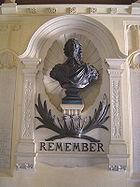
English furniture produced during the reign of Charles I is distinctive and is commonly characterised as Charles I period.
Sainthood
| Saint Charles Stuart | |
|---|---|
| King Charles the Martyr | |
| Born | 19 November 1600(1600-11-19) Dunfermline, Fife, Scotland |
| Honored in | Anglican Communion |
| Canonized | 1660 |
| Major shrine | Church of King Charles the Martyr |
| Feast | 30 January |
| Patronage | Society of King Charles the Martyr, artists |
During the reign of his son Charles II, Charles I was officially canonised by the Church of England as King Charles the Martyr and Saint Charles Stuart, the only saint to be officially canonised within the Anglican Communion. His feast day varies depending on local Anglican liturgical calendars. He is considered a martyr who died for the preservation of Apostolic Succession in the Anglican Church. There are many societies dedicated to his devotion.
Assessments
Archbishop William Laud described Charles as "A mild and gracious prince who knew not how to be, or how to be made, great."
Ralph Dutton says - "In spite of his intelligence and cultivation, Charles was curiously inept in his contacts with human beings. Socially, he was tactless and diffident, and his manner was not helped by his stutter and thick Scottish accent, while in public he was seldom able to make a happy impression."
Titles, styles, honours and arms
Titles and styles
| Royal styles of Charles I of England |
|
|---|---|
 |
|
| Reference style | His Majesty |
| Spoken style | Your Majesty |
| Alternative style | Sire |
| Royal styles of Charles I, King of Scots |
|
|---|---|
 |
|
| Reference style | His Grace |
| Spoken style | Your Grace |
| Alternative style | Sire |
- 19 November 1600 – 27 March 1625: Prince (or Lord) Charles
- 23 December 1603 – 27 March 1625: The Duke of Albany
- 6 January 1605 – 27 March 1625: The Duke of York
- 6 November 1612 – 27 March 1625: The Duke of Cornwall
- 4 November 1616 – 27 March 1625: The Prince of Wales
- 27 March 1625 – 30 January 1649: His Majesty The King
During his time as heir apparent, Charles held the titles of Prince of Wales and Earl of Chester, Duke of Cornwall, Duke of Rothesay, Duke of York, Duke of Albany, Marquess of Ormond, Earl of Carrick, Earl of Ross, Baron Renfrew, Lord Ardmannoch, Lord of the Isles, Prince and Great Steward of Scotland.
The official style of Charles I was "Charles, by the Grace of God, King of England, France and Ireland, King of Scots, Defender of the Faith, etc." (The claim to France was only nominal, and was asserted by every English King from Edward III to George III, regardless of the amount of French territory actually controlled.) The authors of his death warrant, however, did not wish to use the religious portions of his title. It referred to him only as "Charles Stuart, King of England".
Honours
- KG: Knight of the Garter, 24 April 1611 – 27 March 1625
Arms
As Duke of York, Charles bore the arms of the kingdom, differenced by a label argent of three points, each bearing three torteaux gules. As Prince of Wales he bore the arms of the kingdom, differenced by a label argent of three points. Whilst he was King, Charles I's arms were: Quarterly, I and IV Grandquarterly, Azure three fleurs-de-lis Or (for France) and Gules three lions passant guardant in pale Or (for England); II Or a lion rampant within a tressure flory-counter-flory Gules (for Scotland); III Azure a harp Or stringed Argent (for Ireland).
Ancestry
| Ancestors of Charles I of England | ||||||||||||||||||||||||||||||||||||||||||||||||||||||||||||||||||||||||||||||||||||||||||||||||||||||||||||||||||||||||||||||||||||||||||||||||||||||||||||||||||||||||||||||||||||||||||||||||||||||||||||||||||||||||||||||||||||||||||||||||||||||||||||||||||||||||||||||||||||||||||||||||||||||||||||||||||||||||||||||||||||||||||||||||||||||||||||||||||||||||||||||||||||||||||||||||||||||||||||||||||||||||||||||||||||||||||||||||||||||||||||||||||||||||||||||||||||||||||||||||||||||||||||||||||||||||||||||||||||||||||||||||||||||||||||||||||
|---|---|---|---|---|---|---|---|---|---|---|---|---|---|---|---|---|---|---|---|---|---|---|---|---|---|---|---|---|---|---|---|---|---|---|---|---|---|---|---|---|---|---|---|---|---|---|---|---|---|---|---|---|---|---|---|---|---|---|---|---|---|---|---|---|---|---|---|---|---|---|---|---|---|---|---|---|---|---|---|---|---|---|---|---|---|---|---|---|---|---|---|---|---|---|---|---|---|---|---|---|---|---|---|---|---|---|---|---|---|---|---|---|---|---|---|---|---|---|---|---|---|---|---|---|---|---|---|---|---|---|---|---|---|---|---|---|---|---|---|---|---|---|---|---|---|---|---|---|---|---|---|---|---|---|---|---|---|---|---|---|---|---|---|---|---|---|---|---|---|---|---|---|---|---|---|---|---|---|---|---|---|---|---|---|---|---|---|---|---|---|---|---|---|---|---|---|---|---|---|---|---|---|---|---|---|---|---|---|---|---|---|---|---|---|---|---|---|---|---|---|---|---|---|---|---|---|---|---|---|---|---|---|---|---|---|---|---|---|---|---|---|---|---|---|---|---|---|---|---|---|---|---|---|---|---|---|---|---|---|---|---|---|---|---|---|---|---|---|---|---|---|---|---|---|---|---|---|---|---|---|---|---|---|---|---|---|---|---|---|---|---|---|---|---|---|---|---|---|---|---|---|---|---|---|---|---|---|---|---|---|---|---|---|---|---|---|---|---|---|---|---|---|---|---|---|---|---|---|---|---|---|---|---|---|---|---|---|---|---|---|---|---|---|---|---|---|---|---|---|---|---|---|---|---|---|---|---|---|---|---|---|---|---|---|---|---|---|---|---|---|---|---|---|---|---|---|---|---|---|---|---|---|---|---|---|---|---|---|---|---|---|---|---|---|---|---|---|---|---|---|---|---|---|---|---|---|---|---|---|---|---|---|---|---|---|---|---|---|---|---|---|---|---|---|---|---|---|---|---|---|---|---|---|---|---|---|---|---|---|---|---|---|---|---|---|---|---|---|---|---|---|---|---|---|---|---|---|---|---|---|---|---|---|---|---|---|---|---|---|---|---|---|---|---|---|---|---|---|---|---|---|---|---|---|---|---|---|---|---|---|---|---|---|---|---|---|---|---|---|---|---|---|---|---|---|---|---|---|---|---|---|---|---|---|---|---|---|---|---|---|---|---|---|---|---|---|---|---|---|---|---|---|---|---|---|---|---|---|---|---|---|---|---|---|---|---|
|
||||||||||||||||||||||||||||||||||||||||||||||||||||||||||||||||||||||||||||||||||||||||||||||||||||||||||||||||||||||||||||||||||||||||||||||||||||||||||||||||||||||||||||||||||||||||||||||||||||||||||||||||||||||||||||||||||||||||||||||||||||||||||||||||||||||||||||||||||||||||||||||||||||||||||||||||||||||||||||||||||||||||||||||||||||||||||||||||||||||||||||||||||||||||||||||||||||||||||||||||||||||||||||||||||||||||||||||||||||||||||||||||||||||||||||||||||||||||||||||||||||||||||||||||||||||||||||||||||||||||||||||||||||||||||||||||||
Marriage and issue
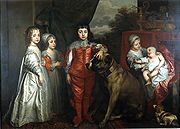
Charles was father to a total of seven legitimate children, two of whom would eventually succeed him as king. His wife also had two stillbirths.
Charles is also believed to have had a daughter, prior to his marriage with Henrietta Maria. Her name was Joanna Brydges, born 1619-20, the daughter of a Miss Brydges ("a member of a younger branch of the ancient Kentish family of that name"), possibly from the line of Brydges of Chandos and Sudeley. Joanna Brydges, who was provided for by the estate of Mandinam, Carmarthenshire, was brought up in secrecy at Glamorgan, Wales. She went on to become second wife to Bishop Jeremy Taylor, author of Holy Living and Holy Dying and chaplain to both Archbishop Laud and Charles I. The Bishop and his wife Joanna Brydges left for Ireland, where Jeremy Taylor became Bishop of Down, Connor and Dromore in 1660. Joanna Brydges and Jeremy Taylor had several children, including two daughters, Joanna Taylor (Harrison) and Mary Taylor (Marsh).
| Name | Birth | Death | Notes |
|---|---|---|---|
| Charles II, King of England, Scotland and Ireland | 29 May 1630 | 6 February 1685 | Married Catherine of Braganza (1638–1705) in 1663. No legitimate issue. Charles II is believed to have fathered such illegitimate children as James Scott, 1st Duke of Monmouth, who later rose against James VII and II. |
| Mary, Princess Royal | 4 November 1631 | 24 December 1660 | Married William II, Prince of Orange (1626–1650) in 1641. She had one child: William III of England |
| James VII and II, King of England, Scotland and Ireland | 14 October 1633 | 16 September 1701 | Married (1) Anne Hyde (1637–1671) in 1659. Had issue including Mary II of England and Anne of England; Married (2) Mary of Modena (1658–1718) in 1673. Had issue. |
| Elizabeth, Princess of England | 29 December 1635 | 8 September 1650 | No issue. |
| Anne, Princess of England | 17 March 1637 | 8 December 1640 | Died young. |
| Henry, Duke of Gloucester | 8 July 1640 | 18 September 1660 | No issue. |
| Henrietta Anne, Princess of England | 16 June 1644 | 30 June 1670 | Married Philip I, Duke of Orléans (1640–1701) in 1661. Had legitimate issue. Among her descendants were the kings of Sardinia and Italy. |
